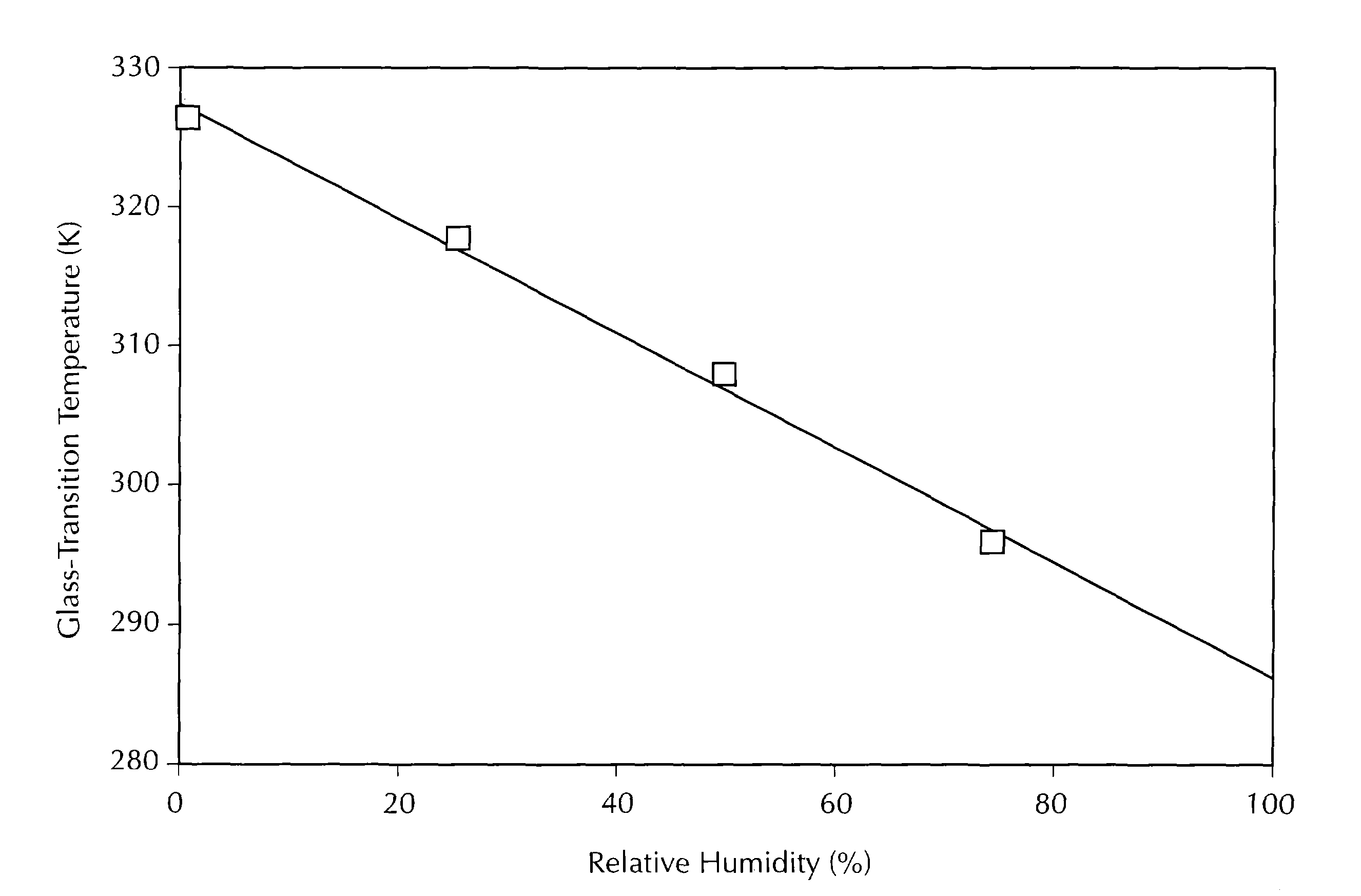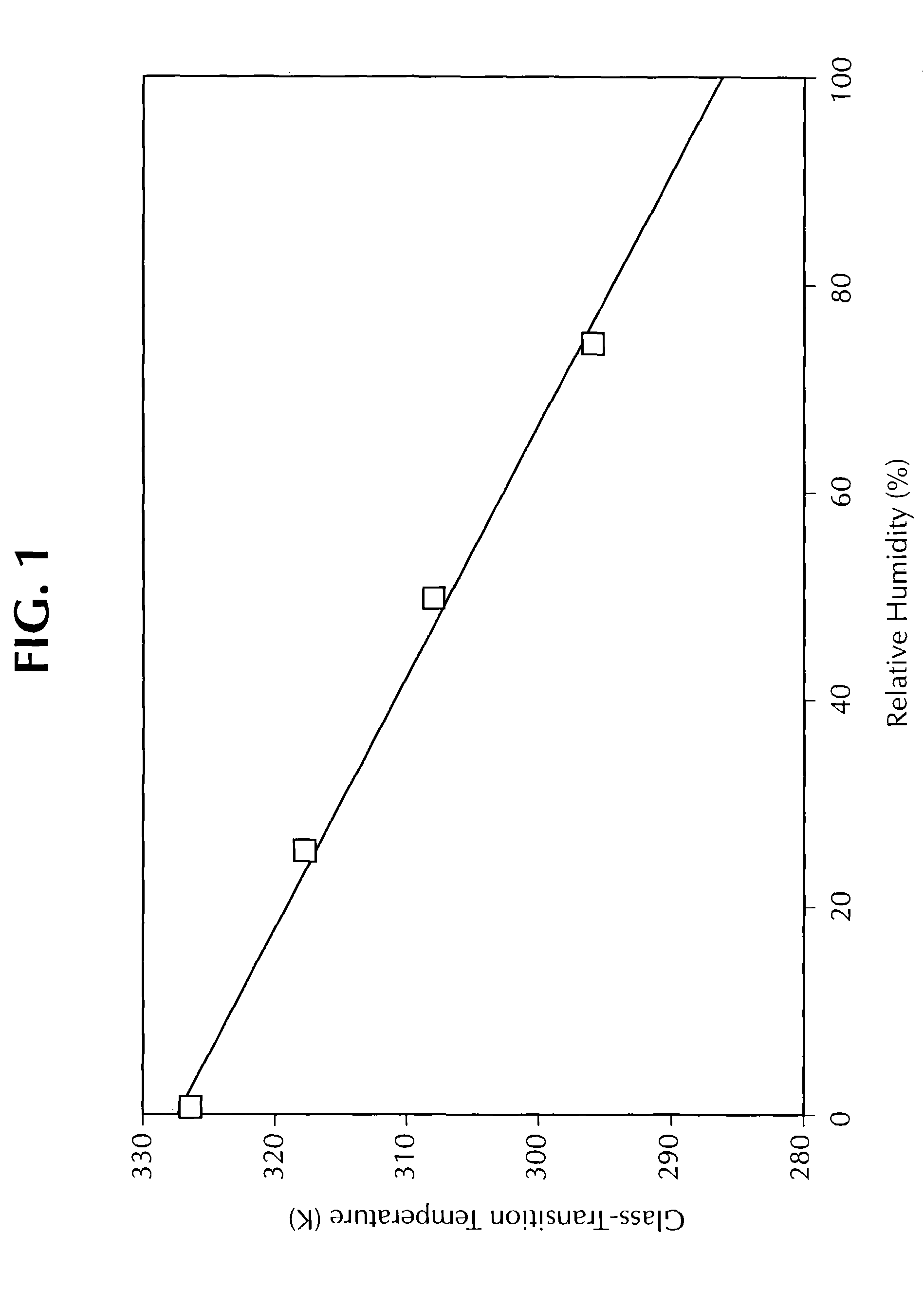Pharmaceutical compositions of semi-ordered drugs and polymers
a technology of semi-ordered states and pharmaceutical compositions, applied in the direction of pharmaceutical delivery mechanisms, medical preparations, powder delivery, etc., can solve the problems of short-lived improvement concentration, poor bioavailability or irregular absorption of low-solubility drugs, and the amorphous forms of drugs may dissolve more rapidly, so as to improve the stability of the drug, improve the stability, and reduce the ability to enhance the concentration of dissolved drugs
- Summary
- Abstract
- Description
- Claims
- Application Information
AI Technical Summary
Benefits of technology
Problems solved by technology
Method used
Image
Examples
examples 1a and 1b
[0304]An initial solid amorphous dispersion of (+)-N-{3-[3-(4-fluorophenoxy)phenyl]-2-cyclopenten-1-yl}-N-hydroxyurea (“Drug 1”) and the polymer hydroxypropyl methyl cellulose (“HPMC”) was made by first mixing Drug 1 in a solvent together with HPMC (grade E3 Prem LV, manufactured by Dow Chemical Co.) to form a solution. The solution, containing 0.25 wt % Drug 1, 0.25 wt % HPMC, 49.75 wt % acetone, and 49.75 wt % methanol, was spray-dried by pumping the solution into a “mini” spray-dryer apparatus at a rate of 1.3 mL / min using a Cole Parmer 74900 series rate-controlling syringe pump. The spray-dryer apparatus was equipped with a Spraying Systems Co. two-fluid nozzle, model number SU1A, using nitrogen as the atomizing gas. The nitrogen was pressurized and heated to a temperature of 100° C. The solution was sprayed from the top of an 11-centimeter diameter stainless steel chamber. The resulting solid amorphous spray-dried dispersion was collected on Whatman® 1 filter paper, dried under...
example 2
[0337]An initial solid amorphous dispersion of 5-(2-(4-(3-benzisothiazolyl)-piperazinyl) ethyl-6-chlorooxindole (Ziprasidone) (“Drug 2”) and an HF grade of hydroxypropyl methyl cellulose acetate succinate (“HPMCAS”) (HF grade from Shin Etsu, Tokyo, Japan) was made by first mixing Drug 2 in a solvent together with HPMCAS to form a solution. The solution, containing 0.3 wt % Drug 2, 2.7 wt % polymer, and 97.0 wt % methanol, was spray-dried by directing an atomizing spray using a two-fluid external-mix spray nozzle at 110 psi at a feed rate of 29 g / min into the stainless-steel chamber of a Niro PSD-1 spray-dryer, using nitrogen as the drying gas, maintained at a temperature of 120° C. at the inlet; the drying gas and evaporated solvent exited the dryer at 75° C.
[0338]The resulting solid amorphous dispersion was collected via a cyclone and then dried in a Gruenberg solvent tray-dryer by spreading the spray-dried particles onto polyethylene-lined trays to a depth of not more than 1 cm an...
example 3
[0352]An initial solid amorphous dispersion of quinoxaline-2-carboxylic acid [4(R)-carbamoyl-1(S)-3-fluorobenzyl)-2(S), 7-dihydroxy-7-methyl-octyl]amide (“Drug 3”) and a vinyl-acetate-vinyl alcohol copolymer (98% hydrolyzed to vinyl alcohol) (“PVA”) was made by first mixing Drug 3 in a solvent together with the PVA (supplied by Aldrich, Milwaukee, Wis.) to form a solution. The solution, containing 1.35 wt % Drug 3, 0.45 wt % PVA, 49.1 wt % water, and 49.1 wt % methanol was spray-dried by pumping the solution into a “mini” spray-dryer apparatus at a rate of 1.3 mL / min using a Cole Parmer 74900 series rate-controlling syringe pump. The spray-dryer apparatus was equipped with a Spraying Systems Co. two-fluid nozzle, model number SULA, using nitrogen as the atomizing gas. The nitrogen was pressurized and heated to a temperature of 100° C. The solution was sprayed from the top of an 11-centimeter diameter stainless steel chamber. The resulting solid amorphous spray-dried dispersion was c...
PUM
| Property | Measurement | Unit |
|---|---|---|
| size | aaaaa | aaaaa |
| size | aaaaa | aaaaa |
| glass transition temperature | aaaaa | aaaaa |
Abstract
Description
Claims
Application Information
 Login to View More
Login to View More - R&D
- Intellectual Property
- Life Sciences
- Materials
- Tech Scout
- Unparalleled Data Quality
- Higher Quality Content
- 60% Fewer Hallucinations
Browse by: Latest US Patents, China's latest patents, Technical Efficacy Thesaurus, Application Domain, Technology Topic, Popular Technical Reports.
© 2025 PatSnap. All rights reserved.Legal|Privacy policy|Modern Slavery Act Transparency Statement|Sitemap|About US| Contact US: help@patsnap.com



